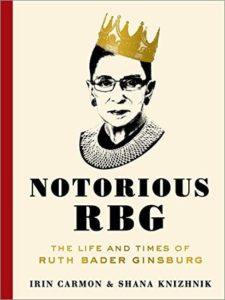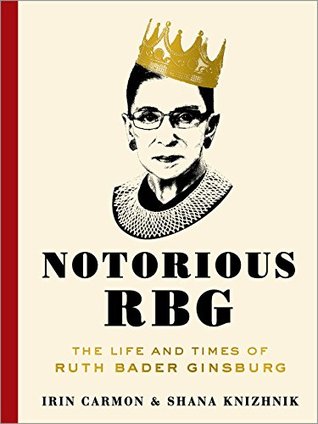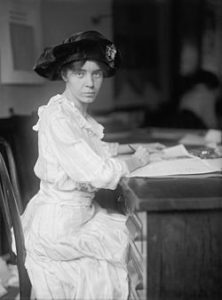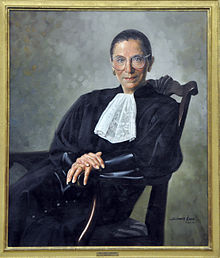Notorious RBG: The Life and Times of Ruth Bader Ginsburg
by Irin Carmon and Shana Knizhnik
 It’s Women’s History Month so here is another entry in books by and/or about women. I’ve been a fan of Ruth Bader Ginsburg since my earliest feminist days. The second woman to join the Supreme Court (appointed by Bill Clinton in 1993), she’s served for twenty-five years as a liberal voice, sometimes shouting into the wilderness; other times changing minds. As the sole women in a tenured position in the Columbia Law School, she co-founded the Woman’s Rights Project at the ACLU in 1971. RGB shepherded some of the most ground-breaking sex discrimination suits through the courts, arguing six cases before the Supreme Court. She won five. She carefully built a foundation of decisions that led to an inevitable conclusion. Discrimination based on gender was unconstitutional.
It’s Women’s History Month so here is another entry in books by and/or about women. I’ve been a fan of Ruth Bader Ginsburg since my earliest feminist days. The second woman to join the Supreme Court (appointed by Bill Clinton in 1993), she’s served for twenty-five years as a liberal voice, sometimes shouting into the wilderness; other times changing minds. As the sole women in a tenured position in the Columbia Law School, she co-founded the Woman’s Rights Project at the ACLU in 1971. RGB shepherded some of the most ground-breaking sex discrimination suits through the courts, arguing six cases before the Supreme Court. She won five. She carefully built a foundation of decisions that led to an inevitable conclusion. Discrimination based on gender was unconstitutional.
A Little History
For those of you too young to remember, the fight to get the Equal Rights Amendment passed in the 60’s and 70’s (it was introduced into the Congress shortly after women got the vote in 1920) was based on the fact that the courts upheld laws that discriminated against women (and sometimes men–more on that below) based on societal norms rather than the “Equal Protection Under Law” guaranteed by the 14th Amendment of the constitution.
In other words, it was legal for states to pass laws prohibiting women from working in certain jobs or after they married or while they were pregnant. There were tons of laws on the books affecting women’s rights to work and equal pay, manage their legal affairs, divorce, or control their own health and fertility. After I got married, I refused to move to certain states because they had “Head of the Household” laws that allowed husbands to dispose of their wives’ property without their consent and have total control of the family resources. In case your wondering, I got married in 1980–not that long ago (at least it doesn’t feel that long ago to me!) The drive to pass the ERA failed, but there were other avenues to equality.
Ruth Bader Ginsburg and the Women’s Rights Project took on those discriminatory laws and practices, piece by piece. One of their tactics was to take on some cases where MEN were discriminated against: the denial of housing available to wives but not husbands of service members; a widowed stay-at-home father denied Social Security benefits for his infant son which were available to widowed wives, etc. RBG argued these cases in front of a Supreme Court made up of all white men. At the time the appellate courts only had one female judge. The brilliance of the tactic was to appeal to the men’s self-interest. “Wow,” they thought, “laws discriminating against men who didn’t conform to societal gender roles were unfair and unconstitutional!”
Those thoughts inevitably led to the logical conclusion that ANY law that discriminated based on gender was unfair and unconstitutional. (Above argument considerably simplifies the legal basis for those cases, but this is a blog post not a Law Review article.) Even with RGB and tons of other women to work on changing society, as well as laws, it took a while to get there. It took many false starts and the occasional assist from Presidents and the Congress to break down the barriers that we have crashed through with several left to dismantle.
The Book
Most of those fights and strategies are reviewed in this book with lots of quotes from RBG’s cases, opinions, and dissents. Which brings me to my problem with the book. It felt padded. My eReader said the book was 266 pages, but it ended at page 161. The rest of the book contained appendices titled “How to be like RGB” which contained philosophic quotes about life and work, “RBG’s Favorite Marty Ginsburg Recipe”, song lyrics “From R. B. Juicy” and a “Scalia/Ginsburg: A (Gentle) Parody of Operatic Proportions,” and much more. The text covering her early years, education, marriage, and career was padded with photos, cartoons, a chapter on her fashion sense (really?), and (as mentioned above) lengthy excerpts from RGB’s opinions. The book is based mostly on reporting from public sources and an interview with one of the authors.
I should have read the blurb more closely: “Notorious RBG: The Life and Times of Ruth Bader Ginsburg, created by the young lawyer who began the Internet sensation and an award-winning journalist, takes you behind the myth for an intimate, irreverent look at the justice’s life and work.” (Emphasis mine.) This book is pitched to Millennials and is exactly what it advertises, so folks looking for a more scholarly treatment and analysis of the great lady’s life and work should look elsewhere. That said, it covers all the facts of her life adequately, gives a good introduction to the legal progress of women’s rights in the past fifty years, brought back memories of activist times past, and reminded me of how much more we have to do in these reactive times. It’s readable and has garnered raves from its intended audience.
In Conclusion
I take great pleasure in the fact that Ruth Bader Ginsburg has become an internet meme and icon to the young. It’s very encouraging for the future. Now go celebrate Women’s History Month. Donate time or money to some women’s cause that is close to your heart. Or read a book about a great woman. Justice Ginsburg has her own memoir, My Own Words, available. Check out her interview with Gwen Ifill from PBS where she discusses her book and becoming “Notorious.”


